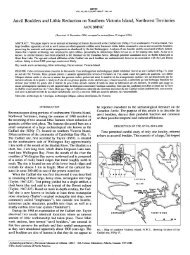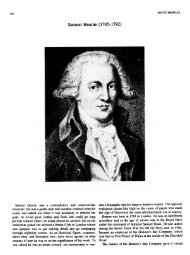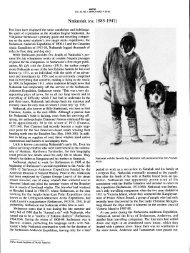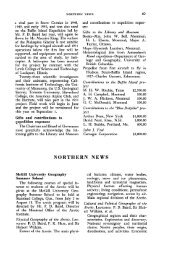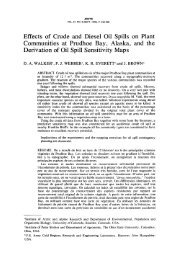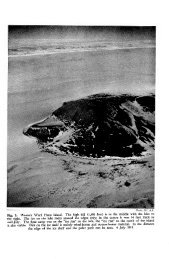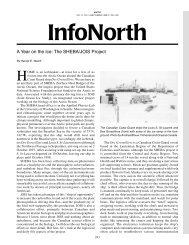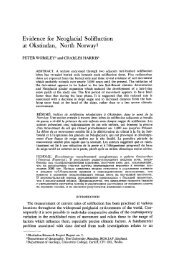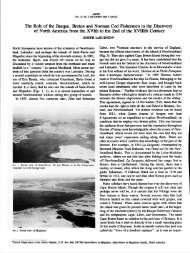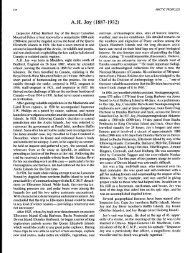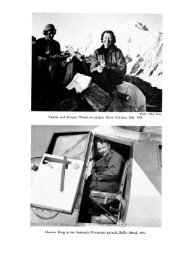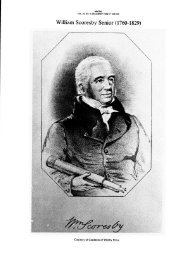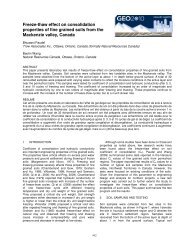NOTES ON THE NUNAMIUT ESKIMO AND MAMMALS OF ... - arctic
NOTES ON THE NUNAMIUT ESKIMO AND MAMMALS OF ... - arctic
NOTES ON THE NUNAMIUT ESKIMO AND MAMMALS OF ... - arctic
You also want an ePaper? Increase the reach of your titles
YUMPU automatically turns print PDFs into web optimized ePapers that Google loves.
180 <strong>THE</strong> NIJNAMIUT <strong>ESKIMO</strong> <strong>AND</strong> ,<strong>MAMMALS</strong> <strong>OF</strong> <strong>THE</strong> ANAKTUVUK PASS REGI<strong>ON</strong><br />
deposited in the U.S. National Museum in 1949 and additional specimens have<br />
since been prepared.<br />
The total length as given by Hall (1929) is large for the Brooks Range<br />
specimens. Male animals, collected in early May, measured from 370 to 380<br />
mm., and females from 340 to 352 mm. For males, the tail length ranged<br />
from 97 to 101 mm., and the foot length from 54 to 63 mm. Nine male<br />
animals, collected from 4 May to 6 May 1949, weighed from 530 to 977 grams<br />
(av. 653 grams). Weight, of course, depends upon season, and the heaviest<br />
animals are obtained just before hibernation.<br />
When caribou are scarce the Nunamiut sometimes kill ground squirrels<br />
for food. They are taken by snares, and, in recent years, by steel traps.<br />
Earlier custom required that a period of time had to elapse after squirrel had<br />
been cooked before the pot could be used for any other meat.<br />
Tamiasciurus hudsonicus preblei Howell. Sakalatayik.<br />
squirrel.<br />
Mackenzie red<br />
The red squirrel does not extend beyond the northern limit of spruce<br />
timber, Seventy-six specimens were obtained in 1950 from the last timber<br />
on the John River and from the Savioyok valley. Four specimens were<br />
deposited in the U.S. National Museum in 1949; a larger series is waiting to be<br />
deposited, and more than 20 are in cold storage. No specimen has been<br />
obtained in summer pelage as practically all summer field work has been north<br />
of timber. The Brooks Range red squirrel reaches a total length of as much<br />
as 376 mm. Six adult females, taken in March, averaged 229 grams in weight,<br />
and 6 adult males, taken at the same time, averaged 258 grams. This is obviously<br />
a larger animal than the specimens upon which the subspecies preblei<br />
is based (Howell, 1936b). It is possible that further study will show that this<br />
squirrel represents a distinct form.<br />
In the Savioyok valley, red squirrels ranging in colour from an unusual<br />
pure ochraceous colour to the normal colour have been taken. The palest<br />
animal had only a few dark hairs along the lateral streaks and on the front legs,<br />
the face, and margins of the tail.<br />
In general habits, this animal does not differ from the same species farther<br />
south. To my knowledge the Nunamiut do not<br />
squirrel.<br />
make any use of the red<br />
Lemmus trimucronatus alascensis Merriam. Avingak. Alaska brown<br />
lemming.<br />
The status of the brown lemming in the Brooks Range is difficult to<br />
determine. I have secured a few specimens south of Tulugak Lake, but it has<br />
been uncommon during the time of this work.<br />
On 6 May 1949, when the spring thaw was just becoming evident, I saw<br />
a brown lemming on a small snow-free area near Tulugak Lake. On July 12<br />
the first specimen, an immature animal weighing 20 grams, was trapped in<br />
“niggerhead” tundra in the main valley, just east of Tulugak Lake. From<br />
September 12 to September 26, however, 14 were obtained in the area of the<br />
flowing springs near the lake. These September specimens weighed from 18 to



